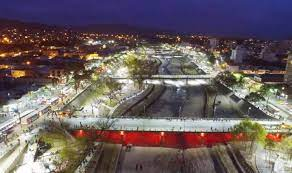Mick McGahey and Jorge Aliaga Cacho in Glasgow.
McGahey led a strike in 1974 which played a part in the downfall of Edward Heath's Conservative
government.
BY EWAN GIBBS
University of Glasgow
Fifty years ago, today, British miners concluded a national strike after defeating their Conservative government.
The 1972 victory opened up a decade of working-class radicalism before Margaret Thatcher’s
counterrevolution crippled organized labor.
Miners at Saltley Coke Works close down the depot during their strike in February 1972. (PA Images via Getty Images)
The British political lexicon presents the 1970s as a decade of economic disaster and political folly. These historical projections reached a fever pitch when Jeremy Corbyn led the Labour Party between 2015 and 2019. Conservative politicians, right-wing newspapers, and even audience members on BBC panel shows conjured up images of recession, failing nationalized industries, and trade union power.
The myth of the 1970s tends to blur three moments into one: the power cuts as a result of the 1972 miners’ strike, the implementation of a three-day week by Edward Heath’s Conservative government during a subsequent coal dispute in 1974, and the spectacle of dead bodies lying unburied as rubbish piled up on British streets during the 1978–79 “Winter of Discontent.” The power of organized labor, whether in the form of industrial action or the bloc votes wielded by so-called union barons at Labour Party conferences, looms large in these stories.
We have to disentangle the 1972 miners’ strike from these hackneyed associations in order to understand Britain’s first national coal dispute since the 1926 general strike when private coal owners had locked out the miners. The strike opened up a crucial phase in postwar British history when it seemed as if working-class radicalism might transform the country’s social order.
Instead, a right-wing backlash led to the rise of Thatcherism, which explicitly set out to tame the working class so that the humiliations of 1972 and 1974 could never be repeated. The defeat of the miners in the third national strike of 1984–85 pushed organized labor into a subordinate position in British society from which it has yet to escape.
The Shadow of Defeat
Popular histories of the early 1970s include Dominic Sandbrook’s State of Emergency and Andy Beckett’s When the Lights Went Out. As Beckett’s title suggests, the central role of coal in British energy production, especially electricity, was crucial to the 1972 strike and the success of the miners in obtaining a landmark pay increase.
Sandbrook puts forward an alarmist reading of the conflict between the National Union of Mineworkers (NUM), on the one hand, and their employers, the National Coal Board (NCB), and the UK government, on the other. Although he does consider the motivation of miners as citizens of an affluent society eager to improve their lot as consumers, we need a more meaningful analysis of their industrial action in 1972. This requires a deeper sense of generational change in the workforce, and of the opportunities and constraints that global energy markets and government policy created, both for miners themselves and for the other industrial workers who supported them.
Thus far, there has been scant commentary on the fiftieth anniversary of one of the most significant industrial disputes to take place in twentieth-century Britain. This is no doubt partly because of the overwhelming significance of the 1984–85 miners’ strike in historical memories of coal mining. The Scottish government recently announced a pardon for Scottish miners convicted of offenses during the yearlong strike after decades of campaigning, and there is still an ongoing campaign for an inquiry into policing tactics at South Yorkshire’s Orgreave coking works on June 18, 1984. Contemporary echoes like this give the later dispute enduring political relevance. New large power stations in the coalfields provided miners with hope as well as potential sources of industrial and political power.
The strike’s thirtieth anniversary in 2014–15 also prompted discussion of the entrenched class and regional inequalities that resulted from the rapid pit closures of the 1980s and ’90s and the devastating impact of deindustrialization. There is an established cultural narrative of heroic but one-sided and ultimately doomed union efforts to resist the domineering power of the British state, portrayed in British films such as Brassed Off, Billy Elliot, and Pride. Acknowledging a period where miners not only fought but won also means challenging that narrative.
The Road to 1972
The strike that shook the British coalfields between January 9 and February 28, 1972, was years in the making. Unofficial action and discontent had been brewing within the NUM since the late 1960s, following a decade in which growing fears over economic security and its future within British energy production had gripped the coal industry. From the mid-1950s to the early 1970s, employment in British coal mining fell from over 700,000 to under 300,000.
The remainder of the mining workforce was concentrated into large collieries using more technologically advanced methods of coal gathering. These included the development of power loading and mechanized cutting. One example was the opening of the Longannet drift mines complex in Fife and Clackmannanshire in Eastern Scotland. The complex conveyed coal from beneath the Firth of Forth directly to a giant new coal-fired power station while keeping miners under external observation and direction through the experimental “remotely operated longwall face” computer technology. Capital-intensive mines, such as those at Longannet, were highly productive but also subject to increased economic pressures, especially within the context of growing fuel competition. In 1970, oil replaced coal as the UK’s dominant fuel source. Coal had comfortably remained king as late as the mid-1950s, supplying transport, industry, and domestic needs. Over the decade and a half which followed, petrol cars and diesel trains displaced coal-fired locomotives and electric-powered trams while homes increasingly abandoned coal heating.
By the early 1970s, the discovery of North Sea gas was encouraging the swift abandonment of town gas, which was produced using coal. Electricity was the only major expanding market, with coal consumption by power stations more than doubling in the twenty years up to 1970, amounting to more than half of British production. New large power stations in the coalfields, such as Longannet in Fife, Ferrybridge in Yorkshire, and Ratcliffe in Nottinghamshire, provided miners with hope as well as potential sources of industrial and political power.
However, the conversion of coal-fired stations to oil firing, the construction of new oil-fired power stations, and the embrace of nuclear technology by Harold Wilson’s Labour government all gave miners reasons to be fearful. The Wilson government’s 1967 Fuel Policy white paper confirmed these fears by projecting a steep decline in coal-mining output and an even starker decrease in employment as demand nose-dived while productivity kept rising.
By the late 1960s, it had been more than two decades since the postwar Labour government had nationalized British coal mining. A generation of miners had matured under public ownership. They had higher expectations of the National Coal Board (NCB), which now ran the mines, than their fathers.
Broadly speaking, the elder generation of miners had compared the nationalized industry favorably to their previous experience of private ownership and mass unemployment before the Second World War. By contrast, miners who had experienced nationalization as young men, or entered the industry after 1947, had grown up in a context of low unemployment and rising working-class incomes. They had also experienced the relative deprivation of miners who lost their status in the postwar years as one of the higher-earning groups within the industrial working class, displaced by male workers in other sectors, such as mass-production manufacturing. Even entry-level janitorial jobs at auto plants commanded better pay rates than skilled tunneling and facework did in the pits.
When I interviewed a group of retired miners in North Lanarkshire for my doctoral research in 2014, they told me about the frustration they experienced when attending football matches or other social occasions where they encountered men who had left the pits for the car factory built at Linwood, to the west of Glasgow, during the 1960s. Their former colleagues were now earning considerably more than they were, in safer and cleaner conditions. By the early 1970s, even entry-level janitorial jobs at auto plants commanded better pay rates than skilled tunneling and facework did in the pits.
Making the Case
The NUM deployed highly moralized language during the 1972 dispute. In a context of state-led income policy and rising government worries over inflation, the miners’ leaders insisted that their members had a “special case” for extensive wage raises. They rooted that case in the dangers and occupational illnesses that miners faced each day while producing the nation’s chief indigenous fuel source.
These arguments resonated as international energy markets seemed increasingly unstable, with rising oil prices and political tensions in the Middle East. The disappointing results of nuclear power further strengthened the view of coal as a strategic resource once again. The miners inspired the sympathy of public opinion and, perhaps more importantly, the solidarity of other workers. There was a symbiosis between a compelling case for justice and the ability of miners and their supporters to exercise economic and political power.
One outcome of the rationalization of coal mining had been the centralization of industrial relations. The signing of a National Power Loading Agreement (NPLA) in 1966 created national wage terms in an industry where pay and conditions had hitherto been notoriously balkanized. NCB management hoped that these agreements would sharply reduce unofficial strikes in coal mines, which they did. Yet the NPLA’s major impact was to unify the interests of mine workers across the British coalfields.
There were indications that pithead discontent was swelling and finding national expression by the late 1960s. One of the first indications came in the autumn of 1969, when an unofficial strike movement began in South Yorkshire in support of a forty-hour week and wage increases for surface workers. Over one hundred thousand miners joined the strike, using tactics that later became emblematic of the 1972 strike. Flying pickets exploited the mobility provided by cars to spread the dispute.
Notably, the NUM Scottish Area also passed a resolution to make the previously unofficial action official in Scotland. In 1970, there was further unofficial action in response to disappointing wage offers after the NUM conference failed to meet the strict requirement for a two-thirds majority in favor of a stoppage. These wildcat strikes resulted in power cuts, demonstrating the strategic leverage of miners. The union subsequently amended its rules, reducing the two-thirds threshold needed for official strike action to 55 percent.
Delegate conferences organized the 1970 strike in Scotland and Wales, indicating the willingness of the leadership in each area to respond to and organize pressure from below. These approaches, along with the practice of flying pickets, were crucial to the organizing of an official dispute in 1972. The rule change made it realistic to achieve a successful national ballot result that year, with almost 60 percent of miners voting for action.
Miners went on strike after an overtime ban, which achieved the important aim of running down coal stocks. It also compelled miners to live on their basic wages, reinforcing their support for the NUM’s pay claim.
Closing the Gates
Miners thus began their dispute in 1972 after more than two years of escalating conflict with the Coal Board. They were responding to a long period of marginalization and declining wages in comparison to other workers. The experiences of unofficial strikes in 1969 and 1970 demonstrated the vitality of workplace activism as well as the potential of miners to precipitate energy shortages.
The miners inspired the sympathy of public opinion and, perhaps more importantly, the solidarity of other workers.
During the 1972 strike, the miners pursued this logic to maximum effect across the British coalfields, rather than on a patchy and haphazard basis, and with a large national union fully behind it. With the mining workforce united behind the NUM’s objectives, the strikers were free to target other workplaces, attempting to stop other workers from moving or handling either coal or imported oil.
They were highly successful in these efforts. Flying pickets in Scotland, England, and Wales convinced unionized railway and power-station workers not to handle coal. They also persuaded lorry drivers to turn back from making deliveries.
Saltley Gate Coke works in Birmingham was the scene of the most famous picket. Arthur Scargill, who would become president of the NUM’s Yorkshire Area two years later, recently described the picket as “the greatest day of my life” in one of the few media reports that commented on the dispute’s fiftieth anniversary. At Saltley Gate, local factory workers from the city’s engineering industry supported the miners in their successful effort to prevent the movement of coal from a strategically important site. The police arrested seventy-six pickets, which was not entirely exceptional in the dispute.
Reginald Maudling, the Conservative home secretary, later recalled the symbolic importance of Saltley Gate:
The number of strikers involved was so great, and feelings were running so high, that any attempt by the relatively small body of police who could be assembled to keep the depot open by force could have led to very grave consequences. Some of my colleagues asked me afterward why I had not sent in troops to support the police, and I remember asking them one simple question: “If they had been sent in, should they have gone in with their rifles loaded or unloaded?”
In her memoirs, Margaret Thatcher tersely described her feelings on the subject: “For me, what happened at Saltley took on no less significance than it did for the Left.”
Under the circumstances, it was hardly surprising that Lord John Widgery was so anxious to whitewash the Bloody Sunday massacre by the Parachute Regiment in Derry, which had happened just a few weeks before the miners’ strike began. Over the course of the 1970s, right-wing politicians and journalists openly discussed the idea that it might be necessary to use British soldiers in order to contain social conflict on the home front.
Ruling-Class Endeavor
Another important picket flashpoint came at the Longannet power station. As labor historian Jim Phillips has argued, Longannet is perhaps more revealing of what gave miners their power in 1972 than Saltley Gate. It was then Britain’s largest power station, responsible for over a quarter of Scotland’s total electricity output. On February 14, the NUM Scottish Area intensified its official picket of the power station, going against the wishes of the NUM’s National Executive.
A policeman kicked Michael McGahey, the NUM Scottish Area’s President. McGahey brushed it off as an accident, although he had to see a doctor the same day, who, he reported, also donated to the NUM’s strike fund. The police arrested thirteen miners at Longannet, who were refused bail and had to face the serious charge of mobbing and rioting. However, they were all found not guilty in June. Right-wing politicians and journalists openly discussed the idea that it might be necessary to use British soldiers to contain social conflict on the home front.
In the Communist Party of Great Britain’s (CPGB) journal Scottish Marxist, McGahey described the arrests and charges as “a classic example of an endeavour on the part of the ruling class to take retribution for the success of a workers’ struggle.” McGahey had been born into a mining family in North Lanarkshire the year before the 1926 dispute. In the course of that strike, his father, Jimmy, who had been a founding member of the CPGB six years earlier, was arrested and imprisoned, while one of his siblings perished.
During the late 1960s and early ’70s, Communists like McGahey and Jack Dunn, a Kent Area official, forged alliances with others on the NUM’s left wing, including Arthur Scargill, Emlyn Williams, then Vice-President of South Wales, and Lawrence Daly, who was general secretary of both the NUM Scottish Area and the NUM as a whole. One important success of the broad left strategy was the leftward shift of the Yorkshire Area, which came about in part through the work of miners who had moved there from contracting coalfields, such as the Scottish activist Jock Kane.
McGahey and Daly went to Downing Street for the negotiations that concluded the strike. After a meeting with Heath, McGahey reportedly sent back some of the prime ministerial cigars he received to the Midlothian coalfields.
The dispute also gave a significant platform to the territorial aspirations of the NUM’s relatively autonomous areas. After hobbling away from his visit to the doctor after the Longannet picket, McGahey addressed the Scottish Trades Union Congress assembly, which made the case for a Scottish Parliament within the UK to empower the organized working class.
The 1972 miners’ strike coincided with the Upper Clyde Shipbuilders work-in. Workers occupied four shipyards in Glasgow and Clydebank that the Heath government had written off as “lame ducks.” Jimmy Reid, the charismatic shop steward who led the occupation, was then also a member of the CPGB. The work-in catapulted Reid to fame across Scotland and Britain, including an appearance on the primetime BBC chat show hosted by Michael Parkinson.
These disputes and their political ramifications underlined the enduring importance of the Communist Party and the organized left for British trade unionism in the late twentieth century. The CPGB might not have had the electoral presence of its sister parties in France, Italy, or Portugal, but its role on the industrial scene was much more significant than its election results would suggest.
Cultures of Solidarity
At the Scottish Area’s 1972 annual conference, McGahey stressed that it was a “picket force” rather than a government-commissioned inquiry into miners’ pay chaired by Lord Richard Wilberforce that had delivered a 27 percent wage increase and other improvements for the union’s membership.
It is hard to disagree with McGahey’s interpretation, but it’s also important to remember the role played by labor movement cultures of solidarity. While the spectacular mobilizations at Saltely Gate and Longannet were important, so, too, were more routine forms of picketing, and the targeting, for example, of smaller power stations by Kent miners, as Diarmaid Kelliher’s recent study of relations between London and the British coalfields demonstrates.It was frustration rather than destitution that motivated the miners.
Half a century after the miners’ 1972 victory, we should understand what drove a workforce to its first national strike action since the 1920s, and why they were successful. It was frustration rather than destitution that motivated the miners. They felt that the Coal Board was not rewarding their efforts justly and feared for their economic security.
They also had the industrial power necessary to demand justice. The still central place of coal in electricity generation and the volatility of international energy markets were vital for achieving major improvements in wages and conditions. So was public sympathy and, more directly, the mobilization of solidarity by other industrial workers.
The miners won another major victory in the 1974 strike, which led to the fall of Edward Heath’s government after the Tory prime minister called an election posing the question “Who rules Britain?” But they subsequently lost their capacity for unified national mobilization and their position of strength within Britain’s political economy.
In part this was because the NCB reshaped incentives within the industry, weakening collective bargaining through the reintroduction of regional bonuses in the late 1970s. More broadly, coal’s place in the British electricity system became progressively weaker. By 1984, there was sufficient nuclear and oil capacity as well as coal stocks built up to render the strategy pursued in 1972 and 1974 redundant.
Margaret Thatcher’s government was able to banish the specter of those earlier victories and chalk up its own symbolic triumph, with consequences that are still being felt today. These outcomes demonstrate that it is the combination of human ingenuity with the contingencies of economic and political power that decide victory and defeat in industrial struggles.
Source: The Jacobine.





















